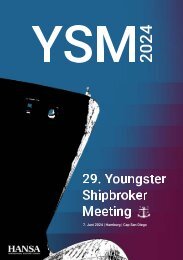HANSA 01-2021
Hull Performance & Coating · Svitzer · Yacht »Soaring« · Schifffahrtsaktien & Börsen · Harren & Partner · LNG in der Schulte-Gruppe · Berenberg Bank · Schiffsinspektionen
Hull Performance & Coating · Svitzer · Yacht »Soaring« · Schifffahrtsaktien & Börsen · Harren & Partner · LNG in der Schulte-Gruppe · Berenberg Bank · Schiffsinspektionen
Sie wollen auch ein ePaper? Erhöhen Sie die Reichweite Ihrer Titel.
YUMPU macht aus Druck-PDFs automatisch weboptimierte ePaper, die Google liebt.
SCHiFFStECHNiK | SHiP tECHNoloGY<br />
in a paper presented at the 19 th international<br />
Conference on Computer applications<br />
and information technology in the<br />
Maritime industries (CoMPit) held in<br />
Pontignano, italy.<br />
The operational scenario chosen for<br />
the analysis follows that of the MUNiN<br />
autonomous and/or unmanned ship<br />
project, which is also used in other analyses.<br />
in this scenario, the vessel is unmanned<br />
during sea passage with the ability<br />
to request remote assistance from a<br />
shore control centre. during manoeuvring<br />
and port stays, the ship is manned,<br />
remote controlled or continuously monitored<br />
from the shore control centre.<br />
The analysis<br />
© Farstad/HaNSa<br />
Navigation related<br />
near miss incidents which occur<br />
while vessel is unmanned:<br />
8%<br />
a total of 481 near misses met the criteria<br />
for having the potential to develop<br />
into a marine accident if not detected and<br />
stopped and were further analysed. one<br />
of the interesting results of the analysis is<br />
that for almost all near misses relating to<br />
navigation, it was assessed that the possibilities<br />
for stopping the incident from<br />
developing into a marine accident were<br />
the same for an unmanned ship as for a<br />
manned ship.<br />
Near misses detected<br />
by onboard human presence:<br />
87%<br />
However, the analysis also showed that<br />
only 8% of near misses relating to navigation<br />
happened when the vessel was in<br />
open sea, which, it must be remembered,<br />
is the only time the ship is assumed to<br />
be unmanned. Therefore, paradoxically,<br />
unmanned operation may have very little<br />
impact on navigational accidents, which<br />
constitute about 70% of marine accidents<br />
globally.<br />
another interesting finding from the<br />
analysis is that 87% of near misses were<br />
discovered by human presence. at the<br />
same time, it was found that in almost<br />
50% of near misses relating to fire and<br />
flooding, the possibility of stopping<br />
the incident from developing into an<br />
accident was evaluated to be worse on<br />
an unmanned ship than on a manned<br />
ship.<br />
Human error was evaluated to be the<br />
cause of 38% of the near misses, which is<br />
a significant portion but still much lower<br />
than the 75% - 96% often referred to for<br />
marine accidents. Whatever the reasons<br />
for this discrepancy, humans are clearly<br />
the cause of many near misses. removing<br />
the crew from the ship does not eliminate<br />
the work needed to operate the ship,<br />
however.<br />
Most of the maintenance work will<br />
need to be done on the ship and other<br />
jobs may migrate to shore control rooms<br />
or shipping offces. The sea is a dangerous<br />
environment and there are factors<br />
such as ship motion, noise and vibrations<br />
that may amplify fatigue and create dangerous<br />
situations. However, workers ashore<br />
are not immune to fatigue or exempt<br />
from human error as countless studies on<br />
workplace safety clearly show. insofar as<br />
the work tasks move from ship to shore,<br />
so too will the near misses and accidents<br />
to a great extent.<br />
Liabilities or assets?<br />
Near misses are not a perfect proxy for<br />
major marine accidents and unmanned<br />
ships will almost certainly not be<br />
constructed simply as a crewless version<br />
of today’s modern cargo ships.<br />
However, this data and these analyses<br />
are important in trying to understand<br />
the challenge of building and operating<br />
the proposed unmanned ships of<br />
the future. The results of this analysis<br />
should not be taken to mean that unmanned<br />
operation is inherently impossible.<br />
They do, however, show some of the<br />
challenges that must be overcome to<br />
get there. today’s manned ships can<br />
be expected to experience one near<br />
miss with the potential to develop into<br />
a marine accident if not detected and<br />
stopped about four times a year. Some<br />
incidents will disappear with the elimination<br />
of the crew, but many will still<br />
happen. incidents will be harder to detect<br />
and more diffcult to stop from turning<br />
into an accident without people<br />
on board. Further, incidents and accidents<br />
which occur because of unmanned<br />
operation are still an important<br />
and yet unknown factor.<br />
author: Stig Eriksen<br />
SdU Mechanical Engineering<br />
department of technology and<br />
innovation<br />
University of Southern denmark<br />
HaNSa – international Maritime Journal <strong>01</strong> | <strong>2021</strong><br />
37


















